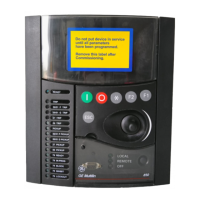GE Multilin F650 Digital Bay Controller 5-83
5 SETPOINTS 5.5 CONTROL ELEMENTS
5
DL-LB OPERATION: Closing permission in dead line – live bus condition.
LL-DB OPERATION: Closing permission in live line – dead bus condition.
SLIP CONDITION: I Internal signal indicating frequency slip between the line voltage and bus voltage
phasors.
BUS FREQ > LINE FREQ: Busbar Frequency higher than line frequency
BUS FREQ < LINE FREQ: Busbar Frequency lower than line frequency
Voltage and frequency values for line and busbar can be obtained, both in primary and secondary values at:
Actual> Metering > Primary Values > Voltage
VBB Primary (KV) Busbar voltage in primary values
VL Primary (KV) Line voltage in primary values
Actual> Metering > Secondary Values > Voltage
Line Voltage (V) Line voltage in secondary values
Bus Voltage (V) Busbar voltage in secondary values
Actual> Metering > Frequency
Line Frequency (Hz) Line frequency in Hz
Bus Frequency (Hz) Bus frequency in Hz
Note on the measure: voltage and current angles are available for the user from firmware version 1.60.
The voltage angles can be obtained in primary metering values (Actual> Metering > Primary Values > Voltage), being the
line voltage angle, the one that corresponds to the voltage set in the frequency reference in General setpoints (please refer
to the voltage correspondence table (Table 5–71:), and the angle of the busbar voltage the one that corresponds to Vx
Angle, when the Auxiliary Voltage setpoint as been selected as VX.
5.5.4.5 ALGORITHM
F650 units perform the synchronism check by basically establishing and comparing three parameters:
Module difference of voltage phasors V (V)
Phase angle of voltage phasors (º)
Frequency slip between two phasors S (Hz)
These parameters are continuously determined and managed once that Unit 25 has been enabled by setpoint, and
in open breaker conditions. It is necessary to consider that all calculations are made once the open breaker condition is
detected; if the breaker is closed or undefined, the synchronism unit will not issue a closing permission signal, even when
closing conditions are met.
If voltage on one side of the breaker to be closed is null, the synchronism unit cannot establish the synchronism check, and
therefore it will not issue synchronism permission. For these cases, usual in breaker maintenance situations, or in new
installations where voltage might not be present, but the breaker operation needs to be verified, F650 units incorporate
closing permission logics for situations of:
Dead Line – Dead Bus (DL-DB)
Live Line – Dead Bus (LL-DB)
Dead Line – Live Bus (DL-LB)
In order to establish the closing permission signal, the first parameter used by the algorithm is the difference in magnitude
between line and bus voltages, and afterwards, the angle difference and frequency slip are verified.
Voltage Difference
V

